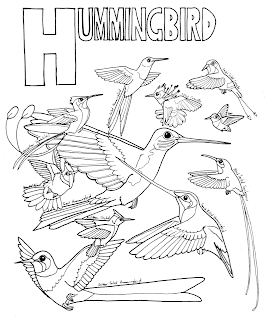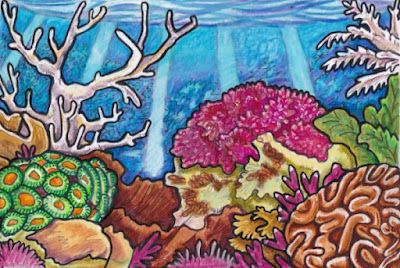As Covid-19 sweeps the planet, NZ has declared it a national emergency and we enter into our lockdown period from midnight tonight.
Now is the time to finally write that book you've always said you'd write - if only you had the time! - it's the chance to take up painting (provided you got the supplies before the stores closed), or make a mark on your "to read" pile, or play board games with family or flatmates or whomever you happen to be staying with on midnight 25th March.
I've decided to share some of my old lineart to educate and entertain. Every few days I'll update my blog with some lineart images that you can print off and colour in. I'll also upload my tutorial on "how to draw a kea" and if you want me to do a tutorial on something else, let me know in the comments below!
These images today come from an unfinished project of mine: a bird alphabet where each page featured a family of birds that began with that letter. Alas, I ran out of motivation (and possibly bird species) because I've only done half the alphabet, but here they are for your colouring pleasure!
Your challenge - should you choose to accept it - is to look up each species (the names are on them in teeny tiny print) and colour them accurately. OR, if you prefer, go wild! Colour them however you want.
And if you do colour them in and want to share your finished image, please comment below!
About the Project
The ZooTrophy Animal-a-Day project began on October 15th, 2013 as illustrator Angela "LemurKat" Oliver began working her way, systematically but selectively, through the alphabet and presenting, via social media, an illustrated animal to the world. Daily.
All pieces are drawn as 2.5 x 3.5 inch collectible cards, using a combination of polychromos and prismacolor pencils, along with other art materials. Many are still available for purchase ($10) or trade, so drop her an email if anything captures your eye or if there is an animal you wish to request.
It is predicted this project will take her at least two years to complete - with approximately 36 animals being drawn for each letter. She has also used the images to create a collectible hardback encyclopedia series, playing cards and a desk calendar, as well as the ZooTrophy collectible trading card game.
All pieces are drawn as 2.5 x 3.5 inch collectible cards, using a combination of polychromos and prismacolor pencils, along with other art materials. Many are still available for purchase ($10) or trade, so drop her an email if anything captures your eye or if there is an animal you wish to request.
It is predicted this project will take her at least two years to complete - with approximately 36 animals being drawn for each letter. She has also used the images to create a collectible hardback encyclopedia series, playing cards and a desk calendar, as well as the ZooTrophy collectible trading card game.
Wednesday, March 25, 2020
Friday, August 12, 2016
#886: Tanager are colorful passerines of the tropics.
When I first drew a Tanager for T, I drew a Western Tanager. Some research determined that Western Tanager were not, in fact, actually Tanager at all, but more closely related to cardinals. Therefore, it has taken a bit of time to get to draw an actual Tanager - in this case the Green-headed Tanager. Yes, I know his head is actually blue...
Tanagers are small passerine birds of the New World, with most species found in the tropics of South America. Flocks are smaller, generally consisting of pairs or up to five individuals, although they may flock together with other species. He follows a predominantly insectivorous diet, with different species using different hunting techniques including hawking and gleaning. Most nests are cup-shaped, although some are almost globular. The female incubates the eggs, tended to by her mate. Several species have been show to utilise helpers in raising the chicks; these are possibly offspring from a previous brood.
Tanagers are small passerine birds of the New World, with most species found in the tropics of South America. Flocks are smaller, generally consisting of pairs or up to five individuals, although they may flock together with other species. He follows a predominantly insectivorous diet, with different species using different hunting techniques including hawking and gleaning. Most nests are cup-shaped, although some are almost globular. The female incubates the eggs, tended to by her mate. Several species have been show to utilise helpers in raising the chicks; these are possibly offspring from a previous brood.
Sunday, July 24, 2016
#885: The Treeshrew has the highest brain:body ratio of any mammal.
The Treeshrews are not actually a shrew at all. Currently, she is considered to be more closely related to the colugo and primate Families. There are 20 species, spread across Southeast Asia. Her brain to body ratio is the highest of any other mammal, including humans, although this is in part due to her small size. She favours an omnivorous diet, feeding on insects, small vertebrates, nuts and seeds. Her maternal skills are relatively weak - her young are born weak and hairless, into a nest of dried leaves, and she suckles them only for a few minutes each day. They grow fast, and will leave the nest within a month and become sexually mature at about four months old.
Thursday, May 26, 2016
Ecosystem: The Ocean covers 2/3s of the Earth's surface.
Ocean covers two-thirds of Earth's surface and contains a variety of ecosystems with greater diversity than those found on land, from the frozen polar reaches, to the warm coral reefs of the tropics and down into the deep and lightless trenchs. There are three main oceans: the Atlantic, the Pacific and the Indian, through which great ocean currents swirl, some carrying warm water, others cool. These influence the world's weather systems.
Life in the oceans ranges from microscopic plankton to the massive blue whale, it is populated with terrifying hunters, deepsea creatures that look to have crawled from your nightmares and other life forms so strange that it is hard to believe they are real. The ocean floor is referred to as the benthic habitat whilst the water itself is the pelagic, both supporting a plethora of life. It is the coral reef, however, that is perhaps the richest in diversity.
There are many threats the ocean and its inhabitants must face, including over-fishing, bottom trawling and pollution. 80% of litter in the water comes from land: anything that ends up in our waterways eventually ends up at sea. Plastic bags, bottles and other non-biodegradable litter has been carried by the currents to form a massive patch of rubbish, known as the Great Pacific Garbage Patch. This plastic disintegrates into smaller and smaller pieces, being consumed by creatures and eventually killing them.
Monday, May 9, 2016
Ecosystem: Grasslands
True to their name, grasslands are areas dominated by a variety of grasses, sedge and rush. They occur on every continent excluding Antarctica. They grow in areas with an annual rainfall between 500 and 1,500mm, where the soil is too low in nutrients for woodland or frequently disturbed by fire or grazing. The roots of the grass form a dense mat, protecting the soil from wind and rain erosion. In many countries (such as Madagascar) degradation of forest habitat by humans has lead to the growth of grassland. Others, like the savannah of Africa and the pampas grasslands of South America, are a natural adaptation to the climate and resources. They provide a variety of habitat, especially for ruminants such as antelopes and their predators.
In countries not historically dominated by grasslands - such as Madagascar and New Zealand - native animals are few, but some - especially hawks - flourish with this more open hunting ground.
In countries not historically dominated by grasslands - such as Madagascar and New Zealand - native animals are few, but some - especially hawks - flourish with this more open hunting ground.
Thursday, May 5, 2016
#884: Yuhina forage in mixed-species flocks, feeding on insects.
Surprise! You thought I was finished, didn't you?
Well, we recently unpacked my "Birds: The Definitive Visual Guide" book, turned to the index and found ... a bird that starts with Y and isn't "Yellow-something". So, how could I resist?
He will replace the Yellowhammer in my XYZ Animal Encyclopedia.
The Yuhina are a genus of Asiatic zosterops, inhabiting tropical and subtropical rainforests. All of the eleven species are crested. He is a sociable bird, occasionally gathering in mixed-species flocks with other Yuhina species. Here he forages on insects, gleaning them from tree branches, or nectar and fruit.
Well, we recently unpacked my "Birds: The Definitive Visual Guide" book, turned to the index and found ... a bird that starts with Y and isn't "Yellow-something". So, how could I resist?
He will replace the Yellowhammer in my XYZ Animal Encyclopedia.
The Yuhina are a genus of Asiatic zosterops, inhabiting tropical and subtropical rainforests. All of the eleven species are crested. He is a sociable bird, occasionally gathering in mixed-species flocks with other Yuhina species. Here he forages on insects, gleaning them from tree branches, or nectar and fruit.
Monday, May 2, 2016
Ecosystem: The Waterways are the lifeblood of the Earth.
Waterways such as rivers, ponds, lakes and streams, are an important part of the ecosystem. Not only do they provide habitat for fish, aquatic mammals and many invertebrates, but they are also play an important role in the lifecycle of many insects and amphibians. Rivers begin at a source - or several sources - and flow towards the sea, entering it at a mouth. The longest river is the Nile in Africa, 6, 650 kms long and the Amazon is the widest - up to 40 kms wide in the rainy season.
Unfortunately, humans have had a powerful influence on many rivers - draining them or building dams, polluting them with both organic and inorganic effluence, and cluttering them with traffic. All of this has an impact on the wildlife that make their homes here. Many aquatic species face extinction - the axolotl's lake habitat has been drained and the extinction of the baiji dolphin resulted from pollution and river traffic.
Subscribe to:
Comments (Atom)

















